Top Virtual Home Staging Apps for 2025: Transform Spaces and Boost Sales
Explore the leading virtual home staging apps of 2025. Effortlessly create realistic virtual tours and transform properties to captivate buyers and accelerate sales.
Want to sell properties faster? This list of the top 7 virtual home staging apps will help you transform vacant listings into buyer magnets. Learn how these powerful tools can help you stage homes virtually, saving you time and money. Empty rooms become inviting spaces with just a few clicks. Discover the best virtual home staging app for your needs, including Pedra, Homestyler, roOomy, BoxBrownie, iStaging, Virtual Staging AI, and VisualStager.
1. Pedra
Pedra stands out as a leading virtual home staging app, offering a comprehensive suite of AI-powered tools designed to transform property listings into captivating visuals. This platform empowers real estate professionals, including agents, home staging companies, and real estate marketers, to effortlessly enhance property presentations and accelerate sales. With just one click, Pedra can furnish, declutter, and renovate interiors and exteriors, optimize lighting, correct perspectives, and even change the sky in property images. This makes it incredibly useful for showcasing off-plan, new-build, and resale properties in their best light. Beyond static images, Pedra also supports realistic renders, dynamic property videos, and unlimited floor plan visualizations. This all-in-one approach simplifies the workflow, providing a centralized platform for a wide range of visual marketing needs.
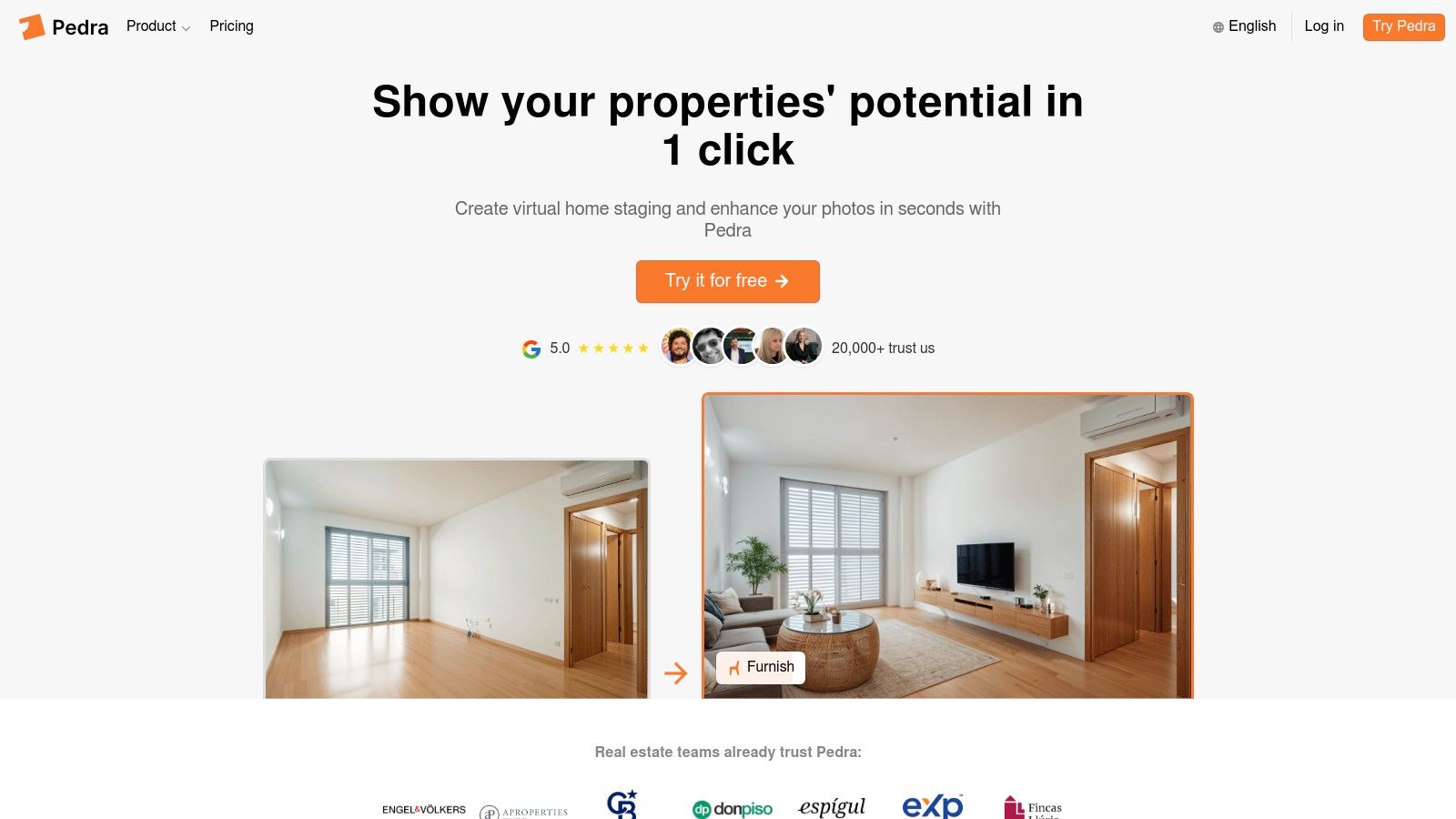
One of Pedra's key strengths is its intuitive interface, requiring no specialized technical expertise. This means realtors and real estate companies can quickly generate professional-grade visuals without needing extensive training or design skills. Imagine easily transforming a vacant property into a warm and inviting home, highlighting its potential to prospective buyers. Or consider effortlessly creating a virtual tour showcasing a property's flow and features, all within a single platform. These capabilities are designed to help close deals faster and attract more buyers with high-quality, impactful visuals.
Pedra offers a flexible subscription starting at €29/month, including 100 image generations. While additional image purchases may be necessary for high-volume users, the base subscription also includes unlimited floor plan visualizations and video creation, providing substantial value. The platform is trusted by over 20,000 users and boasts a 5-star rating, highlighting its strong customer satisfaction and reliable performance. Furthermore, Pedra provides professional image editing and unlimited support, further streamlining the workflow and ensuring high-quality results. While some initial learning may be required to master the advanced features and maximize the software's full potential, the user-friendly design makes the learning curve manageable. Considering the platform's comprehensive feature set, ease of use, and affordable pricing structure, Pedra is an excellent virtual home staging app for real estate professionals looking to elevate their marketing efforts. Learn more about Pedra to understand the advantages of virtual staging over traditional methods. It's a worthwhile investment for those seeking to stay competitive in today's dynamic real estate market. Visit their website at https://pedra.so .
2. Homestyler
Homestyler is a powerful virtual home staging app that allows you to transform empty spaces into beautifully furnished rooms, making it an invaluable tool for real estate agents, interior designers, and homeowners alike. Whether you're preparing a property for listing, visualizing a redesign project, or simply exploring different décor options, Homestyler offers a comprehensive suite of features to bring your vision to life. Its user-friendly interface combined with a vast library of real furniture products makes it a top contender in the virtual staging landscape. You can create 3D floor plans from scratch with precise measurements, or even take a photo of an empty room and digitally stage it with furniture and décor elements, offering potential buyers a realistic glimpse into the possibilities of the space.
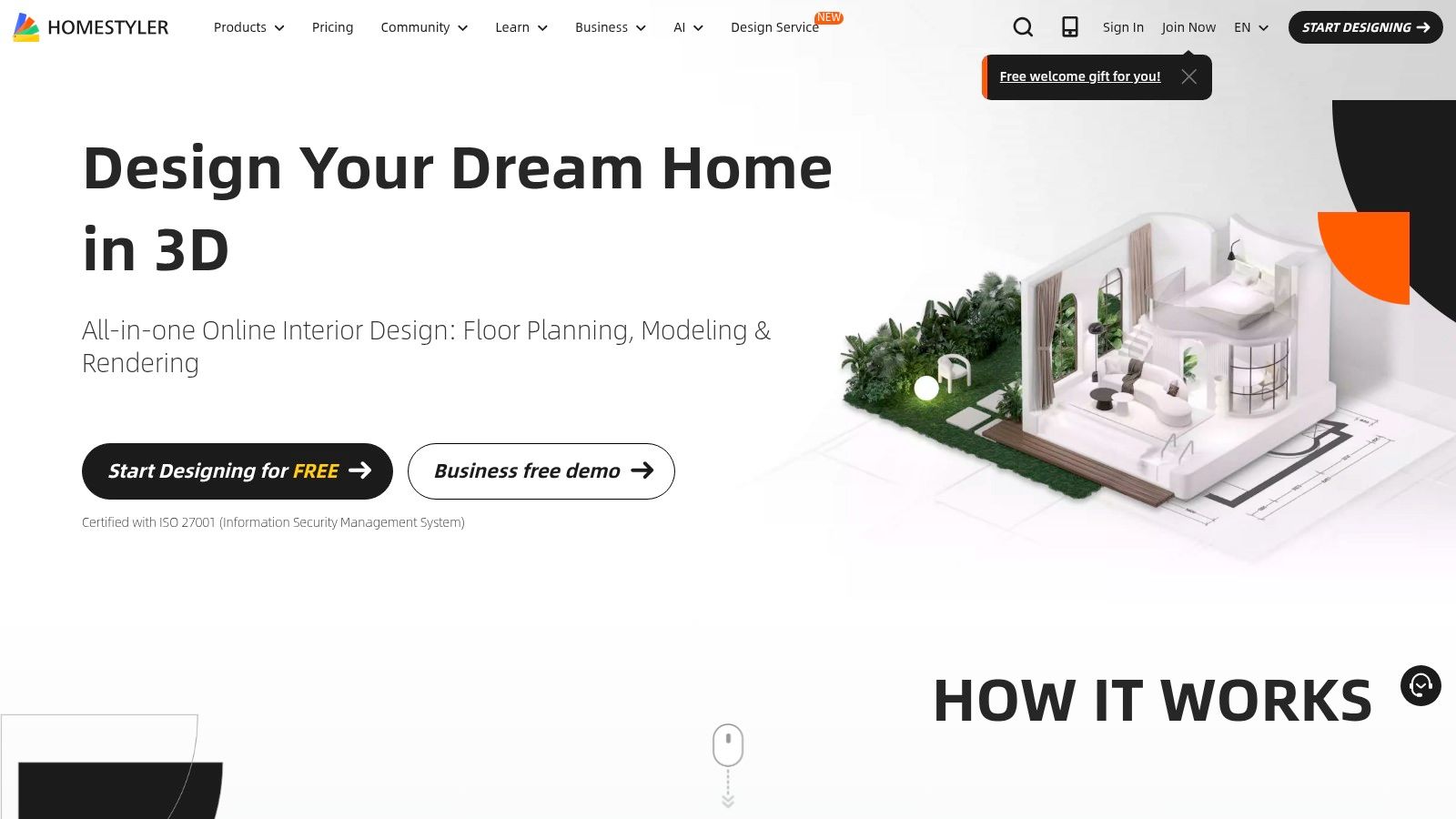
One of Homestyler's key strengths lies in its extensive catalog of real furniture products. Unlike some virtual staging apps that use generic models, Homestyler partners with real brands, allowing users to incorporate actual furniture pieces into their designs. This not only adds a layer of realism but also provides a convenient way for users to source the items they love directly through the app. This feature is particularly appealing to real estate agents staging properties for sale, as they can create visually appealing spaces with readily available furniture, enticing potential buyers and potentially accelerating the sales process. Realtors and real estate companies can leverage this feature to showcase properties in their best light, attracting more interest from prospective buyers.
For real estate marketing and home staging businesses, Homestyler is a game-changer. It allows for quick and cost-effective staging, eliminating the need for physical furniture and lengthy photoshoots. This streamlined process can translate to significant savings in both time and money, while still delivering high-quality visuals for marketing materials. Imagine showcasing a vacant property with various design styles to appeal to a broader audience – Homestyler makes this possible with just a few clicks.
Homestyler offers both web and mobile app versions, providing flexibility for users to work on their projects from anywhere. The free basic version offers a robust set of features for getting started, while premium subscriptions unlock advanced functionalities such as high-resolution rendering and expanded access to the furniture catalog. While the rendering of high-quality images can be time-consuming and the learning curve for advanced features might be steep, the user-friendly interface makes the basic functions easily accessible to beginners. Some users have reported occasional software crashes, something to keep in mind while working on important projects.
Pros
- User-friendly interface suitable for beginners
- Extensive furniture catalog with real products
- Both web and mobile app versions available
- Free basic version with reasonable functionality
Cons
- Premium features require a subscription
- Rendering high-quality images can be time-consuming
- Some users report occasional software crashes
- Learning curve for advanced features
Website: https://www.homestyler.com/
Homestyler deserves a prominent place on this list due to its comprehensive features, user-friendly interface, and the significant advantage of using real furniture products. Whether you're a seasoned interior designer or a homeowner looking to refresh your space, Homestyler offers a valuable tool for visualizing and realizing your design aspirations.
3. roOomy
roOomy stands out as a premier virtual home staging app, offering high-quality 3D renderings that bring empty properties to life. It's a powerful tool for real estate professionals, from individual realtors to large marketing firms, looking to showcase a property's full potential and attract buyers. Unlike some virtual staging apps that offer generic furniture placements, roOomy partners with major furniture retailers, allowing for the integration of real, purchasable products into the virtual staging. This feature elevates the realism and provides a tangible connection for potential buyers who can envision themselves living in the space with those specific pieces. Imagine showcasing a vacant listing with a stylish, fully furnished living room – all achievable without the logistical and financial burdens of traditional staging. This is the power of roOomy.
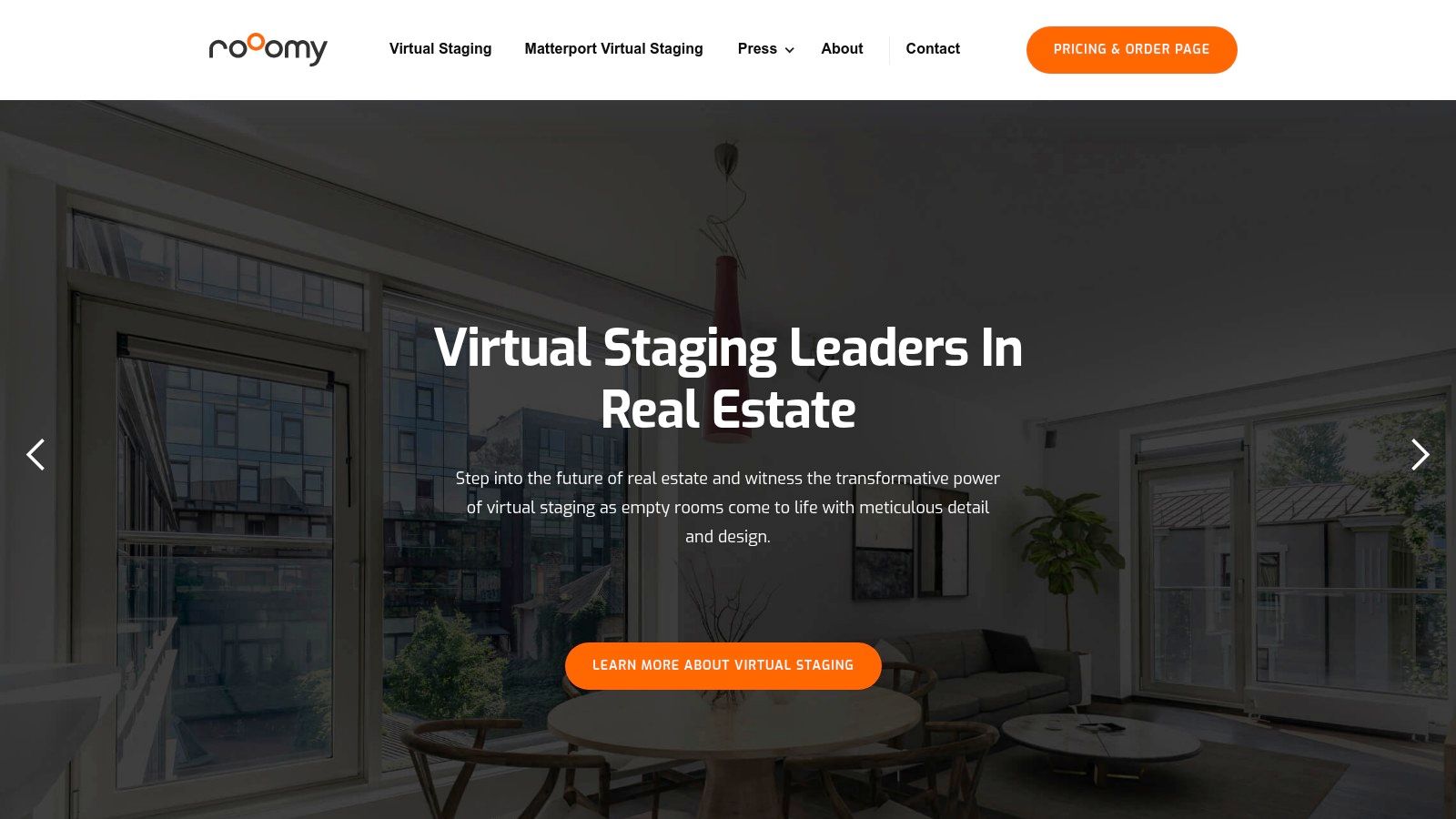
This virtual home staging app offers various services to cater to different needs. If you're looking for a hands-off approach, roOomy provides professional design services where experienced interior designers create custom virtual stagings. For those who prefer a more DIY approach, the platform also offers self-service tools, although these come with a steeper learning curve. roOomy's AR/VR capabilities further enhance the experience, allowing potential buyers to take immersive virtual tours of the staged property, experiencing it as if they were truly there. This interactive element can be a game-changer, especially for remote buyers or those with busy schedules.
While roOomy's pricing is higher than some competitors, the quality of its renderings and the integration with real furniture brands justify the investment for many professionals. The ability to transform existing rooms with various design styles also caters to diverse buyer demographics. If you're targeting first-time homebuyers, you might choose a modern, minimalist aesthetic. For luxury properties, you might opt for a more opulent and classic style. roOomy empowers you to tailor the staging to your specific target audience.
Features
- Photorealistic virtual staging of empty spaces
- AR/VR capabilities for immersive property tours
- Integration with leading furniture retailers' catalogs
- Custom design services by professional interior designers
- Ability to transform existing rooms with different furniture styles
Pros
- Extremely high-quality renderings with photorealistic results
- Partnership with major furniture retailers for actual product placement
- Professional staging services available for a hands-off approach
- Supports multiple design styles for different buyer demographics
Cons
- Higher price point than many competitors
- Professional services can have longer turnaround times
- Limited DIY options compared to some alternatives
- Steeper learning curve for the self-service tools
Website: https://rooomy.com/
roOomy earns its place on this list as a top-tier virtual home staging app because of its commitment to realism, its innovative AR/VR features, and its ability to connect with buyers on a deeper level through the integration of real furniture products. While the higher price point might be a consideration, the potential return on investment in terms of faster sales and higher perceived property value makes it a worthwhile virtual home staging app for serious real estate professionals.
- BoxBrownie: Professional Virtual Home Staging Services
For real estate professionals seeking a hassle-free and high-quality virtual home staging solution, BoxBrownie stands out as an excellent choice. Unlike DIY virtual staging apps, BoxBrownie operates on a service model. You simply upload your photos, and their team of expert designers takes care of the rest, adding furniture and decor virtually to enhance your property listings. This makes BoxBrownie a particularly appealing option for busy real estate agents, home stagers, and marketing agencies who value speed, quality, and convenience. Its popularity in the real estate industry stems from the quick turnaround times, reasonable pricing, and consistently professional results.
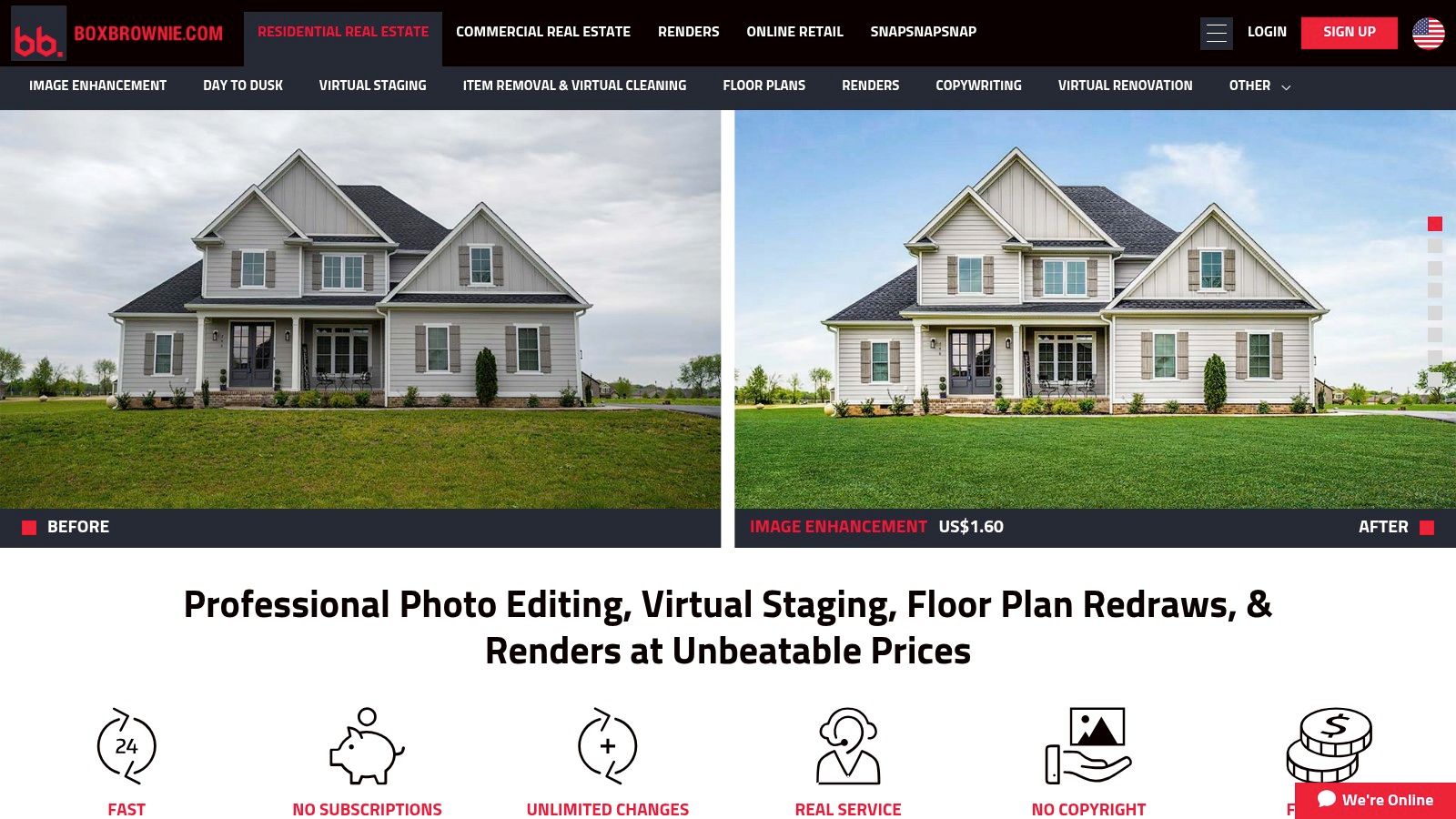
BoxBrownie excels in providing professional virtual staging services designed to elevate property listings. Imagine needing to stage a vacant living room in a modern style. With BoxBrownie, you simply upload a photo of the empty room, select the desired style (modern, in this case), and their designers work their magic within 24-48 hours. You receive back a professionally staged image ready to attract potential buyers. This service is invaluable for showcasing the potential of a property, especially for vacant or poorly furnished listings. No need to wrestle with complicated software or spend hours arranging virtual furniture yourself – BoxBrownie's team handles it all.
This virtual home staging app alternative's pay-as-you-go pricing model is also a significant advantage, especially for those who don't require ongoing staging services. You only pay for the images you need staged, avoiding recurring subscription fees. While the cost per image can add up for numerous rooms or properties, the convenience and professional quality often outweigh the expense, especially when compared to the cost of traditional home staging.
Beyond virtual staging, BoxBrownie offers a suite of other valuable services for real estate professionals, including image enhancement, floor plan redraws, and twilight conversions. This makes it a one-stop shop for enhancing property marketing materials.
Features
- Professional virtual staging by skilled designers (not DIY)
- Fast 24-48 hour turnaround on most virtual staging orders
- Consistent quality across all staged images
- Various style options including modern, traditional, and contemporary
- Additional services including image enhancement, floor plans, and twilight conversions
Pros
- No learning curve since professionals do the work
- Pay-per-use model with no subscription required
- Consistently high-quality results
- Extremely quick turnaround times
Cons
- Not a DIY solution for those wanting creative control
- Costs can accumulate for multiple rooms or properties
- Limited ability to make minor adjustments without additional charges
- No real-time preview of results
Website: https://www.boxbrownie.com/
BoxBrownie deserves a place on this list because it provides a practical and efficient solution for real estate professionals who need high-quality virtual staging without the time commitment or learning curve of DIY apps. It's a valuable tool for showcasing a property's potential and attracting buyers in a competitive market. While it might not be suitable for those on a tight budget or seeking complete creative control, the speed, convenience, and professional results offered by BoxBrownie make it a compelling option for many in the real estate industry.
- iStaging: Your All-in-One Virtual Home Staging and Tour App
iStaging stands out as a comprehensive virtual home staging app, offering a powerful suite of tools designed to elevate real estate marketing. This platform goes beyond simply staging rooms by integrating virtual tour capabilities, providing a truly immersive experience for potential buyers. This makes it an invaluable tool for real estate agents, home staging companies, and anyone looking to showcase a property in its best light. Whether you're looking to furnish an empty space or create a 3D walkthrough, iStaging empowers you to transform your property presentation.

One of iStaging's key strengths lies in its combination of virtual staging and virtual tour features. With the VR Maker app, you can capture 360° panoramas directly from your smartphone and seamlessly weave them into interactive virtual tours. This streamlined workflow empowers real estate professionals to create engaging content on-the-go, saving valuable time and resources. Imagine letting clients explore a fully furnished property from the comfort of their own homes, even before it's physically staged – that's the power of iStaging. Their furniture and decor catalog offers a range of customizable items to perfectly match the target audience and property style. Learn more about iStaging to get valuable home staging tips that complement the virtual staging process.
iStaging utilizes a cloud-based platform, allowing access from multiple devices and promoting seamless collaboration between team members. While pricing details aren't explicitly mentioned on their main marketing materials, it's generally considered reasonable compared to competitors offering similar features. However, keep in mind that the subscription model might be less cost-effective for infrequent users. While the mobile app is known for its ease of use, mastering all of iStaging's features and tools might require some dedicated learning. Although iStaging provides regular updates with new furniture models and features, the furniture catalog might be slightly limited compared to some competitors, and the quality of the virtual staging, while generally good, might not always reach the photorealistic levels achieved by specialized staging services.
Key Features and Benefits:
- Combined Virtual Staging and Virtual Tours: Create a complete property experience with integrated staging and tour capabilities.
- 360° Panorama Capture & VR Tour Creation: Easily create immersive virtual tours using your smartphone.
- Mobile App for On-the-Go Content Creation: Stage and create tours from anywhere, anytime.
- Customizable Furniture & Decor Catalog: Personalize spaces to match your vision and target audience.
- Cloud-Based Platform: Access your projects from any device and collaborate with ease.
Pros
- All-in-one solution for virtual staging and tours
- Easy-to-use mobile application
- Reasonable pricing for its feature set
- Regular updates with new content and features
Cons
- Quality may not always be as photorealistic as specialized staging services.
- Requires a learning curve to master all functionalities.
- Furniture catalog can be limited compared to competitors.
- Subscription model may be costly for infrequent use.
Website: https://www.istaging.com/
6. Virtual Staging AI
Virtual Staging AI is revolutionizing the real estate market with its AI-powered virtual home staging app. This innovative platform automates the traditionally time-consuming and costly process of staging a home, making it an attractive option for real estate agents, home staging companies, realtors, and real estate companies looking to quickly and affordably enhance their property listings. Simply upload photos of empty rooms, and the AI intelligently detects the space, automatically furnishing and decorating it within minutes. This speed and efficiency make it a game-changer for those needing to stage multiple properties quickly.
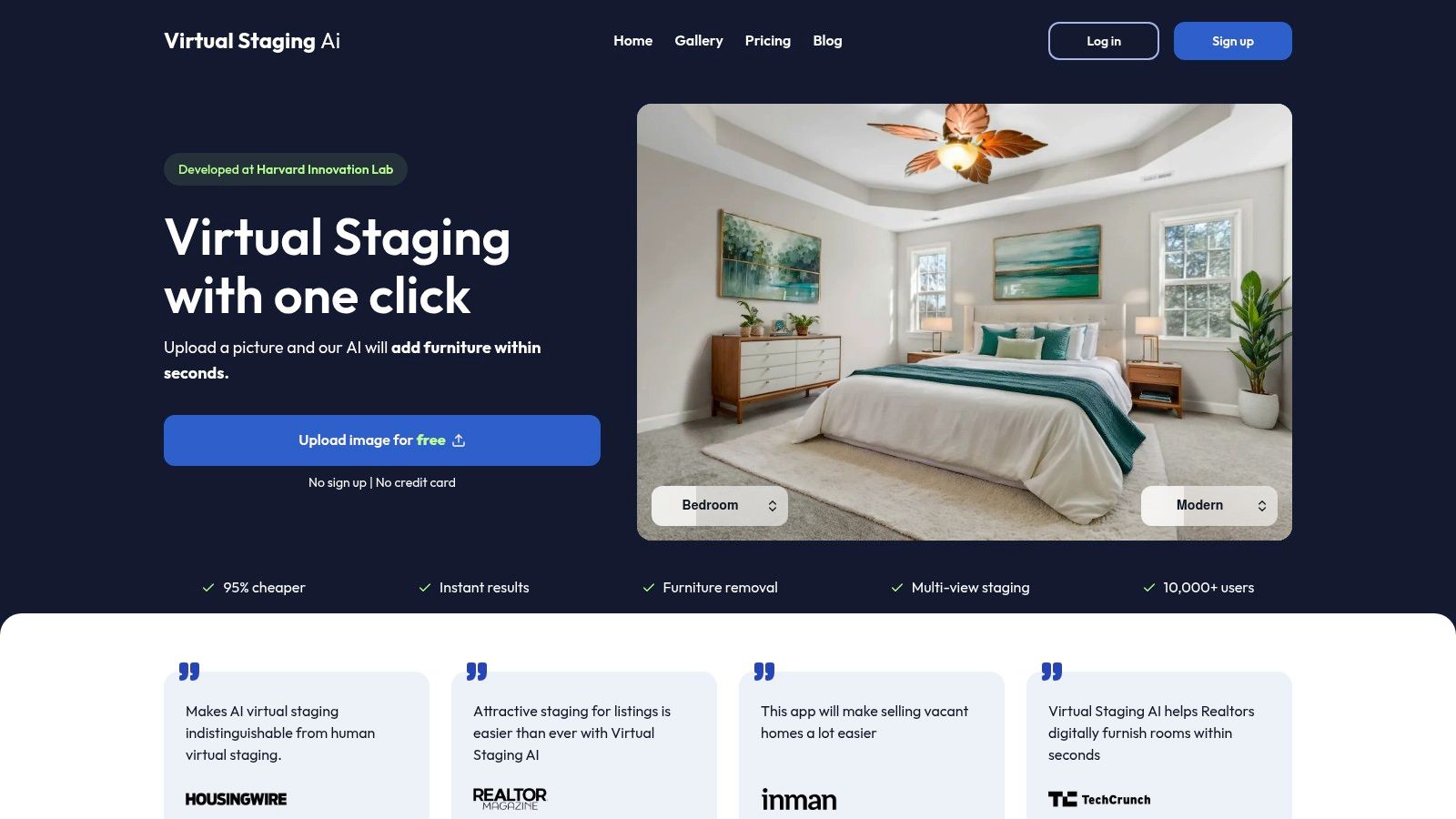
Imagine being a realtor with a vacant listing. Instead of coordinating traditional staging, which can take days and incur significant costs, you could utilize Virtual Staging AI to create stunning visuals almost instantly. Upload photos of the empty rooms, choose a preferred interior design style from the available options, and let the AI work its magic. In mere minutes, you have professional-quality images ready to attract potential buyers. This virtual home staging app empowers you to present a beautifully furnished space, even when the property is empty, helping buyers visualize the home's potential and ultimately leading to faster sales. Learn more about Virtual Staging AI for a deeper understanding of this process.
While specific pricing details aren't readily available, the automated nature of the service makes it significantly more affordable than traditional virtual staging services, which often rely on manual design work. This affordability allows inmobiliarias and real estate companies to stage more properties without breaking the bank. The platform requires no special technical expertise, making it user-friendly even for those unfamiliar with virtual staging.
Features
- AI-powered automated virtual staging
- Multiple interior design styles
- Results delivered in minutes
- Simple upload and selection process
- Ability to stage multiple rooms quickly
Pros
- Extremely affordable compared to traditional virtual staging
- Near-instant results with no waiting period
- No technical expertise required
- Consistent quality across different room types
Cons
- Less customization than manual staging services
- AI can occasionally make placement errors in complex room layouts
- Limited ability to select specific furniture pieces
- Fewer style options than some competitors
Despite the limitations in customization, Virtual Staging AI's speed, affordability, and ease of use make it a valuable tool for those in the real estate industry. It's particularly beneficial for busy professionals who need quick turnaround times and cost-effective solutions for showcasing their properties. You can explore the platform further at https://virtualstagingai.app/ . This virtual home staging app provides a practical and efficient way to enhance your listings, appealing to a wider range of buyers and ultimately helping you close deals faster.
7. VisualStager
VisualStager is a powerful virtual home staging app specifically designed to meet the fast-paced needs of real estate professionals. This browser-based platform eliminates the need for downloads or complex software, allowing realtors, home staging companies, and real estate marketers to quickly and easily transform empty property photos into warm and inviting spaces. Whether you're looking to showcase a vacant listing or help potential buyers envision the possibilities, VisualStager offers a streamlined workflow with its intuitive drag-and-drop interface and extensive library of furniture and decor. This makes it a practical choice for boosting your property marketing efforts. VisualStager's focus on simplicity and efficiency makes it an excellent virtual home staging app option for busy professionals looking to elevate their listings.
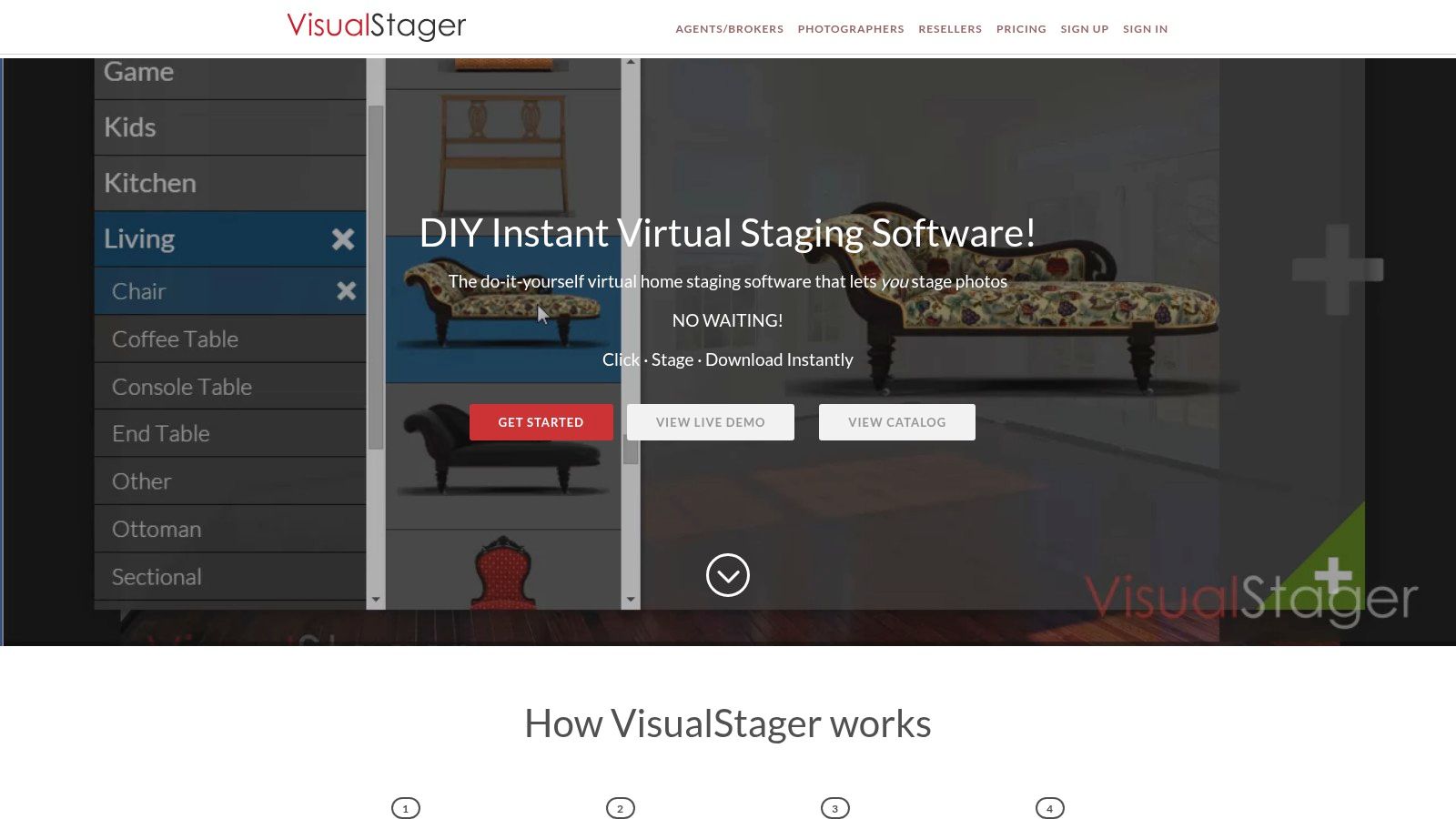
One of the key advantages of VisualStager is its user-friendly design. The drag-and-drop interface requires no prior design experience, making it accessible to anyone. Choose from a vast library of furniture and decor, customizing items with different colors to match your desired aesthetic. You can even save your favorite furniture collections for quick staging across multiple projects, further enhancing your workflow. This is particularly beneficial for real estate agents juggling numerous listings or staging companies working on multiple properties simultaneously. The ability to process multiple rooms efficiently allows you to stage an entire property quickly and effectively, saving you valuable time and resources.
VisualStager operates on a credit-based pricing model, providing flexibility and cost-effectiveness for both occasional and frequent users. This eliminates the need for a costly subscription, allowing you to purchase credits as needed. Compared to some premium virtual staging services, VisualStager offers a more budget-friendly option without sacrificing essential functionality. While its photorealism might not match some higher-end platforms, the quality remains suitable for effective property marketing. The platform's room prep tools are also somewhat limited in comparison to comprehensive design platforms, but they still offer enough to create compelling virtually staged images.
Implementation Tips
- Start with a clear photo: Ensure your property photos are well-lit and free of clutter for optimal staging results.
- Plan your layout: Before you begin dragging and dropping, consider the furniture arrangement and overall aesthetic you want to achieve.
- Utilize the customization options: Explore the color palettes and furniture variations to create a personalized and inviting atmosphere.
- Save your favorite combinations: Take advantage of the saved collections feature to streamline your staging process for future projects.
Pros
- Extremely easy to learn and use
- Credit-based pricing model with no subscription required
- Quick workflow designed for real estate professionals
- Ability to process multiple rooms efficiently
Cons
- Less photorealistic than some premium services
- Limited room prep tools compared to comprehensive design platforms
- Furniture library not as extensive as some competitors
- No mobile app version available
Website: https://www.visualstager.com/
VisualStager deserves its place on this list due to its user-friendly interface, efficient workflow, and cost-effective pricing model. It's a valuable virtual home staging app solution for busy real estate professionals seeking a simple yet powerful tool to enhance their marketing materials and ultimately sell or rent properties faster.
Virtual Home Staging Apps Comparison
| Product | Core Features & Capabilities | User Experience & Quality ★ | Pricing & Value 💰 | Target Audience 👥 | Unique Selling Points ✨ |
|---|---|---|---|---|---|
| 🏆 Pedra | Virtual staging, photo/video enhancement, floor plans | ★★★★★ Intuitive, fast, pro-grade | €29/month (100 images) + extras | Real estate pros, marketers, stagers | All-in-one AI, rapid editing, 20k+ users |
| Homestyler | 3D floor plans, virtual furniture catalog | ★★★★ User-friendly, realistic | Free + Premium subscription | Agents, interior designers, homeowners | Real furniture models, web & mobile |
| roOomy | Photorealistic 3D staging, AR/VR tours | ★★★★★ High-quality, professional | Higher-priced plans | Real estate agents, luxury market | AR/VR immersive tours, pro design |
| BoxBrownie | Pro virtual staging service, quick turnaround | ★★★★★ Consistent, expert edits | Pay-as-you-go, no subscription | Occasional users, agents | Pro-designed, fast delivery, pay-per-use |
| iStaging | Virtual staging + 360° tours, mobile capture | ★★★★ Integrated, mobile-friendly | Subscription-based, moderate price | Agents wanting tours + staging | VR tours, mobile app, cloud accessible |
| Virtual Staging AI | AI automated staging, fast results | ★★★★ Affordable, quick | Low cost, pay-per-use | Budget-conscious agents | AI automation, instant results |
| VisualStager | Browser-based staging, drag-and-drop interface | ★★★ Easy, efficient | Credit-based, no subscription | Agents needing fast, simple staging | No download, customizable items |
Ready to Transform Your Virtual Staging?
Virtual home staging has become an essential tool for real estate professionals, offering an efficient and cost-effective way to showcase a property's potential. Throughout this article, we've explored seven powerful virtual home staging apps – from industry giants like roOomy and BoxBrownie to innovative solutions like Virtual Staging AI and VisualStager, and also including user-friendly options like Homestyler and iStaging. Each platform offers unique features and capabilities, catering to a variety of needs and budgets. Remember to consider factors like cost, ease of use, and the level of customization you require when selecting the perfect app for your projects.
Ready to take your virtual staging to the next level? Dive deeper into the world of virtual staging and its benefits for boosting sales with this comprehensive guide on home staging virtuel from Gepetto. It provides valuable insights and practical advice for maximizing your virtual staging efforts.
Choosing the right virtual home staging app can significantly impact your ability to connect with potential buyers and close deals faster. Whether you're a seasoned real estate agent or just starting out, leveraging the power of virtual staging can transform your listings and elevate your business. By implementing these tools strategically, you can create stunning visuals, engage buyers emotionally, and ultimately, achieve greater success in the competitive real estate market.
Ready to experience the power of virtual staging firsthand? Explore Pedra , a powerful virtual staging app that simplifies the process of creating stunning, realistic visuals. Pedra offers a range of features and integrations, making it easy to transform your listings and impress potential buyers.
Real estate photography is constantly changing. New technologies give agents exciting new options for showcasing properties and attracting buyers. This section explores those advancements, concentrating on practical uses and their return on investment (ROI).
Aerial Photography: Taking Listings to New Heights
Aerial photography, especially using drones, offers a unique perspective impossible with traditional photography. Drones capture expansive views, showcasing the surrounding area and highlighting key features. Think landscaping, pools, and proximity to desirable amenities. This broad perspective helps potential buyers visualize the property and its location – a critical factor in their decision-making.
For instance, a drone shot can perfectly capture a large backyard, something hard to convey with ground-level photos. They can also highlight nearby parks, schools, or shopping centers, providing valuable context for buyers.
Virtual Tours: Immersive Experiences That Drive Engagement
Virtual tours create immersive experiences, allowing potential buyers to explore a property from anywhere. These 360-degree walkthroughs give buyers a realistic sense of the space, layout, and flow, helping them imagine themselves living there.
This is especially helpful for out-of-town buyers or those with busy schedules, eliminating the need for multiple in-person visits. Virtual tours also increase buyer engagement, leading to more qualified leads. They simply offer a more complete and engaging viewing experience than static images can.
The growth of real estate photography is clear, with advanced visual tools becoming more common. By 2025, 82% of real estate agencies were using drones, and homes with aerial photos sold 68%faster. Around22% of home listings now include virtual tours, offering immersive experiences for potential buyers. Learn more from these real estate photography statistics .
Integrating Technology for Comprehensive Marketing Packages
Smart real estate agents are incorporating these technologies into complete marketing packages. By combining professional photography, aerial shots, and virtual tours, they create dynamic and eye-catching presentations. These packages showcase properties in the best possible way, maximizing their appeal.
The ROI of Emerging Technologies
While these technologies require an upfront investment, the potential ROI is significant. Aerial photography and virtual tours can reduce time on market, boost buyer interest, and ultimately lead to higher sale prices.
These tools allow agents to offer premium marketing services, justifying higher commissions and attracting more listings. Investing in technology isn't just about showcasing properties; it's about building a modern, tech-savvy brand. Agents who embrace innovation and leverage technology will gain a competitive edge and position themselves for greater success.
Editing Workflows That Maintain Authenticity
Post-processing is where good real estate photography becomes great. It's the art of transforming raw images into compelling visuals that tell a property's story. However, there's a fine line between enhancement and misrepresentation. This section explores ethical editing workflows that elevate a property's appeal while maintaining authenticity.
Essential Editing Sequence for Real Estate Images
Professional real estate photographers typically follow a specific editing sequence to ensure consistency and quality. The workflow usually begins with global adjustments, such as correctingwhite balanceandexposure. This establishes the foundation for further edits.
Next, they'll address perspective distortion, a common problem with wide-angle lenses. Correcting vertical and horizontal lines helps rooms appear more natural and balanced. This step is followed by local adjustments, focusing on specific areas within the image, such as brightening shadows or reducing glare.
Finally, color correctionandcontrast adjustments add vibrancy and depth. The aim throughout this process is to enhance, not fabricate, the reality of the property.
Time-Saving Workflows and Consistency
Maintaining consistency across a set of property images is crucial for a professional presentation. Using presets in editing software like Adobe Lightroom can significantly speed up the workflow. Presets help ensure a uniform look and feel across all photos.
Think of a preset as a recipe for editing. It applies a pre-defined set of adjustments, saving time and effort. This ensures a cohesive visual narrative throughout the property's photos.
Correcting Perspective, Balancing Light, and Window Exposures
Wide-angle lenses, while essential for capturing spacious interiors, can distort lines. This can make rooms appear unnatural. Perspective correction tools in editing software help straighten these lines, creating a more accurate depiction. This process is especially important for properties with distinctive architectural features. For a more detailed explanation, check out our guide on real estate photo editing services .
Balancing mixed lighting can be a challenge. This is particularly true when natural light from windows combines with artificial interior lights. Techniques like HDR blending, which combines multiple exposures, help capture detail in all areas. This creates a balanced and natural-looking image.
Window pull, where the view outside is overexposed, is a common issue. Correcting this involves carefully adjusting the window area's exposure. This reveals the outside view without losing interior detail.
Ethical Considerations and Avoiding Misrepresentation
While enhancing images is acceptable, misrepresenting a property is unethical. Removing permanent fixtures, dramatically altering room sizes, or concealing structural flaws is misleading. This can also have legal consequences. The goal of real estate photography is to present a property attractively while maintaining accuracy.
Presenting an accurate depiction builds trust with potential buyers and prevents issues later.
Buyer Engagement and the Impact of Over-Processing
Subtle use of techniques like HDR blending can increase buyer engagement. However, over-processed images often deter buyers. These images are characterized by overly saturated colors, unrealistic HDR effects, and excessive sharpening. They look artificial and can raise doubts about the property's actual condition.
A nuanced approach to editing is essential. The goal is to enhance the image, not create a fantasy.
Acceptable Improvement vs. Misleading Manipulation: Defining the
Boundaries
Understanding the difference between acceptable enhancement and misleading manipulation is crucial for ethical real estate photography. Adjusting brightness, contrast, and color saturation to create a more appealing image is generally acceptable.
However, digitally adding non-existent features, removing permanent fixtures, or drastically changing the property's appearance is unethical. It's also potentially misleading. By adhering to ethical editing practices, photographers build trust and contribute to a transparent real estate market. This involves a commitment to accuracy and a focus on enhancing reality, not fabricating it.
Looking for a simpler way to enhance real estate photos? Pedra , an AI-powered software, offers a range of tools for virtual staging, realistic renders, and photo enhancements – all with a single click.
- Canon TS-E 24mm f/3.5L II Tilt-Shift Lens
For real estate photography, controlling perspective is crucial. The Canon TS-E 24mm f/3.5L II Tilt-Shift lens is a premium piece of real estate photography equipment specifically designed to address this need. Say goodbye to distorted images where walls appear to lean inwards – a common problem with standard wide-angle lenses. This lens allows you to correct converging vertical lines, ensuring professional-looking, straight-walled interiors and exteriors. This makes it a worthwhile investment for realtors, real estate companies, home staging businesses, and real estate marketing professionals looking to elevate their property listings.
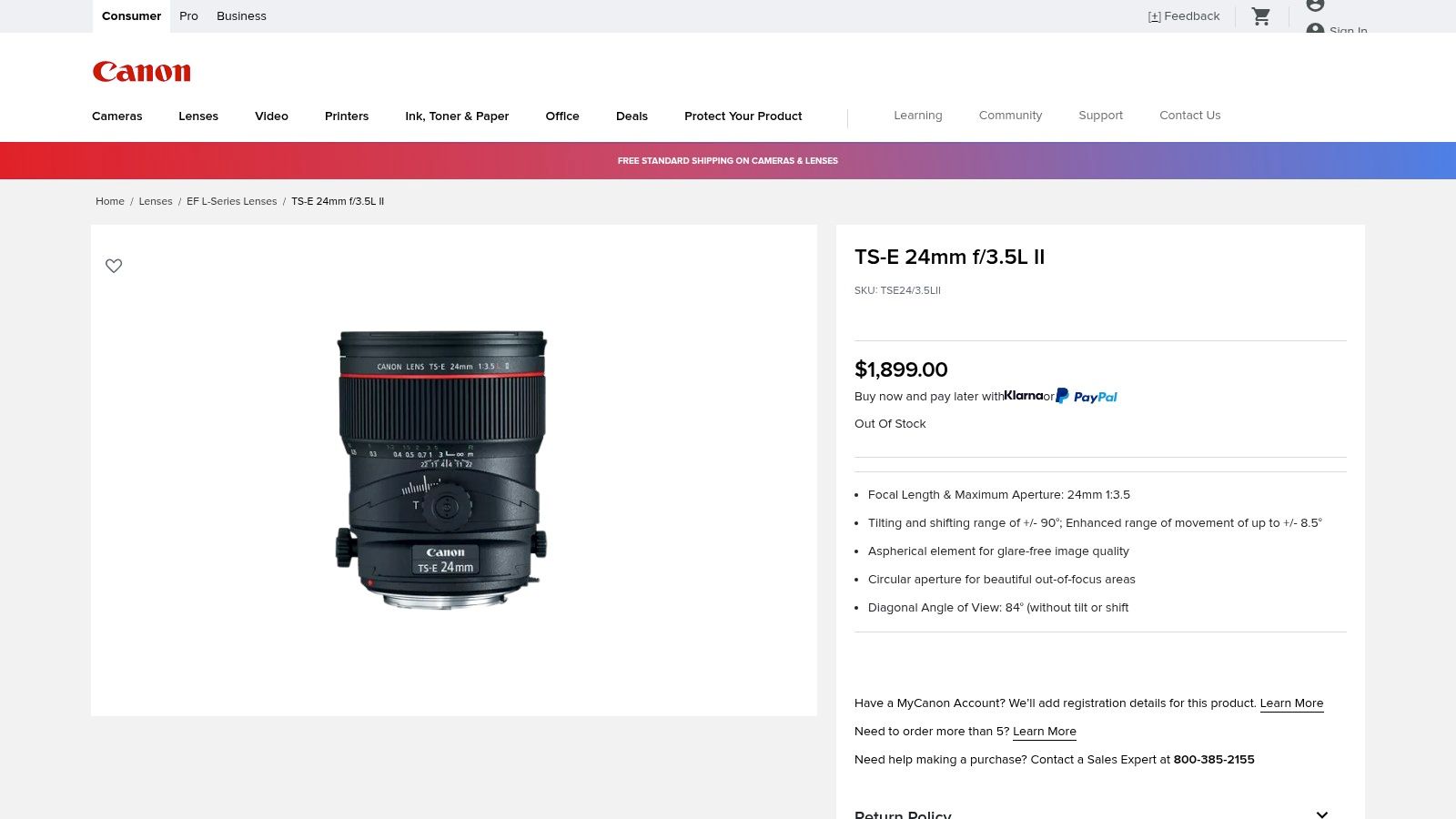
The 24mm focal length is ideal for capturing spacious interiors, offering a wide field of view without excessive distortion. Its tilt-shift mechanism gives you precise control over perspective, with ±8.5° tilt and ±12mm shift adjustments. While other wide-angle lenses might capture more of a room, they often introduce unwanted distortion. The Canon TS-E 24mm f/3.5L II combats this, allowing you to showcase a property accurately and attractively. Imagine capturing a stunning kitchen with perfectly straight cabinets and countertops, or a high-rise building standing tall without the converging lines – this lens makes it possible.
The manual focus design, combined with ultra-low dispersion glass elements, guarantees exceptional image quality and sharpness. This level of control and clarity sets this lens apart in the realm of real estate photography equipment. While it has a steeper learning curve compared to standard autofocus lenses, the results speak for themselves. It's a tool for serious real estate photographers who understand the impact of high-quality visuals on property sales.
While the Canon TS-E 24mm f/3.5L II carries a premium price tag (MSRP $1,899) and requires manual focus operation, its ability to correct perspective distortion and deliver exceptional image quality makes it a valuable investment for real estate professionals. Its weather-sealed construction adds to its durability and longevity, protecting your investment.
Pros
- Superior perspective control eliminates converging vertical lines
- Exceptional image quality and sharpness
- Minimal distortion compared to standard wide-angle lenses
- Allows for creative focusing effects
- Weather-sealed construction
Cons
- Very expensive ($1,899 MSRP)
- Steeper learning curve than standard lenses
- Manual focus only
- Large and heavy construction
Implementation Tip
Practice using the tilt-shift movements on different scenes before your first real estate shoot. Mastering the manual focus and understanding the effect of tilt and shift will allow you to capture truly stunning images.
Canon TS-E 24mm f/3.5L II Product Page
- Manfrotto MT055XPRO3 Aluminum Tripod
Investing in the right real estate photography equipment can significantly elevate your listings and attract more potential buyers. A crucial piece of this equipment is a sturdy tripod, and the Manfrotto MT055XPRO3 Aluminum Tripod stands out as a professional-grade option designed for the demands of real estate photography. This tripod offers the stability and versatility you need to capture those perfect, sharp images that truly showcase a property.
This tripod earns its place on this list due to its robust construction, flexible positioning options, and ability to support heavier camera setups. While there are cheaper alternatives, the MT055XPRO3 prioritizes stability and durability, which are essential for consistent, high-quality real estate photography. It's an investment that will pay off in the long run with crisp, professional photos.
One of the standout features of the MT055XPRO3 is its innovative 90-degree center column mechanism. This allows you to quickly switch from vertical to horizontal positioning, opening up creative framing possibilities, especially useful for capturing wide interior shots or detailed architectural features. Imagine easily switching to a bird's-eye view for showcasing a kitchen island or capturing a sweeping panorama of a living room – this tripod makes it effortless. The Quick Power Lock system allows for rapid leg adjustments, saving you valuable time on location. Whether you're shooting in a cramped condo or a sprawling estate, you can quickly adapt to the environment and frame your shots perfectly.
The MT055XPRO3 boasts a maximum height of 66.9" and a load capacity of 19.8 lbs, making it suitable for even the heaviest DSLR or mirrorless camera setups with professional lenses. This stability is crucial for sharp images, especially in challenging lighting conditions where longer exposures might be necessary. Built-in bubble levels ensure precise alignment, eliminating crooked horizons and ensuring your images look professional.
Pros
- Rock-solid stability: Capture tack-sharp images even with long exposures, vital for low-light interiors.
- Versatile positioning: The 90-degree center column allows for creative angles and perspectives, perfect for showcasing unique architectural details or capturing expansive room shots.
- Durable construction: Built to withstand the rigors of professional use, ensuring long-term reliability.
- Easy setup and adjustment: The Quick Power Lock system makes it quick and easy to adjust the tripod's height and leg angles, saving you time on location.
Cons
- Weight: At 5.5 lbs, it's heavier than carbon fiber options, which might be a consideration for real estate agents frequently traveling between properties.
- Bulk: Can be bulky when fully extended, potentially making it less convenient for tight spaces.
- Price: At $249.99, it represents a higher investment compared to entry-level tripods.
- Head not included: Requires a separate head purchase, adding to the overall cost.
Implementation Tip
When setting up the MT055XPRO3, take advantage of the adjustable leg angles to achieve maximum stability on uneven terrain. Don't forget to utilize the bubble level to ensure your camera is perfectly aligned for straight horizons.
For real estate professionals aiming to capture high-quality images that truly impress potential buyers, the Manfrotto MT055XPRO3 Aluminum Tripod is a worthwhile investment. While it comes at a premium price, its stability, versatility, and durability make it a valuable addition to your real estate photography equipment arsenal.
Manfrotto MT055XPRO3 Aluminum Tripod
- Godox AD200Pro Flash
The Godox AD200Pro Flash is a game-changer for real estate photography equipment setups, offering a powerful and portable lighting solution that elevates interior shots from average to stunning. This flash system delivers a robust 200Ws of power, more than enough to illuminate large rooms and combat challenging lighting situations often encountered in real estate photography. While a basic speedlight might struggle in a spacious living room, the AD200Pro provides ample power to fill the space with beautiful, even light. This extra power also allows you to use modifiers like softboxes and umbrellas effectively, creating a more professional and polished look.
One of the standout features is its interchangeable flash head system. You can quickly switch between a standard speedlight head for directional light and a bare bulb head for a broader, more omnidirectional spread. This versatility makes the AD200Pro adaptable to various real estate photography scenarios. Need to highlight architectural details in a hallway? Use the speedlight head. Want to create a soft, ambient glow in a bedroom? Switch to the bare bulb. This adaptability is invaluable for real estate agents, home stagers, and real estate marketing companies looking to showcase properties in their best light.
Beyond its power and versatility, the AD200Pro shines with its portability. Being battery-powered, you can easily move it around a property without being tethered to a power outlet. This is a huge advantage for real estate photographers who need to be nimble and efficient on location. The built-in 2.4GHz wireless X system offers a reliable 328' range, giving you the freedom to position the flash precisely where you need it. The fast recycle time of 0.01-2.1 seconds ensures you won't miss crucial shots, especially during fast-paced shoots. For those working with tight deadlines, this speed and efficiency are crucial.
While the Godox AD200Pro is a powerful tool, there is a slight learning curve involved in mastering optimal flash placement and power settings. It also requires additional triggers for camera synchronization, adding to the overall cost. Priced around $349, it is a more significant investment compared to basic speedlights. Furthermore, battery life can diminish with frequent full-power usage, so carrying spare batteries is recommended. However, for serious real estate photographers, the benefits of the AD200Pro far outweigh the drawbacks. Learn more about Godox AD200Pro Flash
Key Features and Benefits
- 200Ws Power Output: Illuminates large interiors effectively.
- Interchangeable Heads: Offers versatile lighting options with speedlight and bare bulb heads.
- Portable and Battery-Powered: Enables freedom of movement on location.
- Wireless Control: Provides convenient and flexible flash placement.
- TTL and Manual Modes: Caters to various shooting styles and skill levels.
Pros
- Powerful enough to light large rooms
- Portable and battery-powered
- Versatile with interchangeable heads
- Compatible with various triggering systems
Cons
- Requires additional triggers
- Learning curve for optimal use
- More expensive than basic speedlights ($349)
- Battery life diminishes with heavy use
Website: https://www.godox.com/products/ad200pro/
This powerful and portable flash system is a worthwhile investment for anyone serious about elevating their real estate photography equipment and producing high-quality images. It earns its place on this list due to its power, versatility, and portability, making it a valuable tool for real estate professionals. By utilizing the Godox AD200Pro, realtors, real estate companies, and home staging businesses can significantly enhance the visual appeal of their property listings, capturing the attention of potential buyers and ultimately driving sales.
7. DJI Mavic 3 Drone
Elevate your real estate photography with the DJI Mavic 3 drone, a professional-grade tool that captures breathtaking aerial perspectives of properties. This drone revolutionizes real estate marketing by providing stunning visuals that stand out. Its Hasselblad camera system, known for its exceptional image quality, ensures your property listings are presented in the best possible light. The Mavic 3's advanced features, such as obstacle sensing and extended flight time, allow you to capture comprehensive aerial coverage of properties and their surrounding landscapes. This makes it an invaluable piece of real estate photography equipment for showcasing everything from sprawling estates to cozy suburban homes.
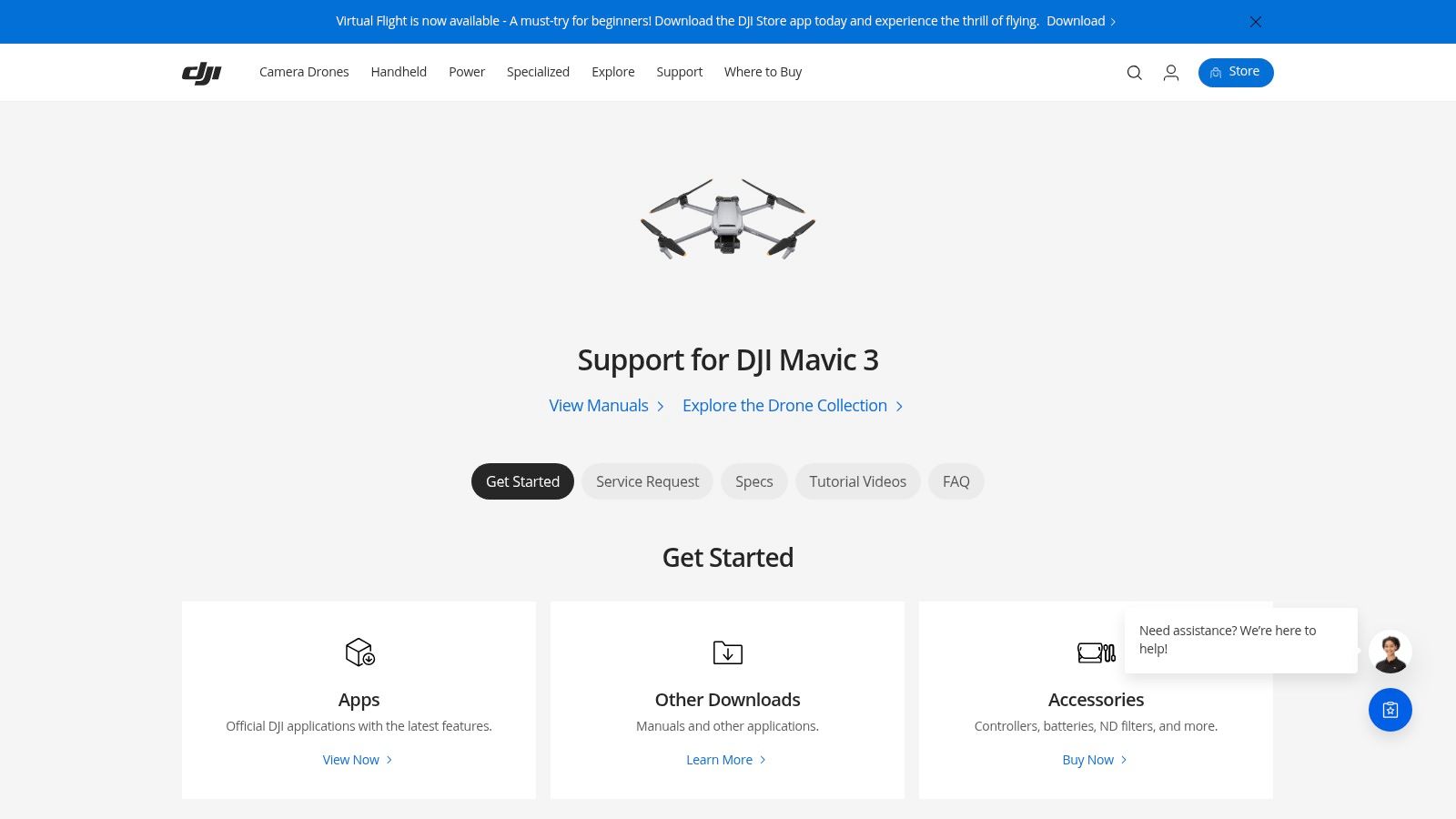
Real estate agents, realtors, and real estate companies can leverage the Mavic 3 to create compelling marketing materials. Capture sweeping views of the property, highlight its location within the neighborhood, and showcase nearby amenities like parks and schools. For home staging and real estate marketing companies, the Mavic 3 offers a unique perspective to potential buyers, making properties more attractive and memorable. Imagine showcasing a beachfront property with a dramatic flyover shot or highlighting the expansive acreage of a rural estate. These dynamic visuals provide a comprehensive understanding of the property's layout and surroundings, impossible to achieve with traditional ground-level photography.
The Mavic 3 boasts a Hasselblad 4/3 CMOS sensor with 20MP resolution, providing crisp, high-quality images. The adjustable aperture, ranging from f/2.8 to f/11, allows for creative control over depth of field. With a maximum flight time of 46 minutes, you can cover large properties without needing to swap batteries mid-flight. The omnidirectional obstacle sensing ensures safe operation, particularly valuable when flying near buildings. Furthermore, the 10-bit D-Log color profile provides enhanced flexibility for post-processing, allowing you to achieve professional-grade color grading.
While the DJI Mavic 3 represents a significant investment (starting at $2,049 for the standard package), its capabilities justify the price for serious real estate professionals. It's important to be aware of legal requirements like FAA registration and potentially Part 107 certification. Weather conditions can also limit shooting opportunities. While the drone is designed for ease of use, there is a learning curve for mastering smooth flight control and composition. For realtors looking to create interactive property experiences, learn more about DJI Mavic 3 Drone and how aerial footage can be integrated.
Pros
- Superior image quality with Hasselblad camera system
- Extended flight time covers large properties
- Compact folding design for easy transport
- Advanced safety features reduce crash risk
Cons
- Significant investment
- Requires FAA registration and potentially Part 107 certification
- Weather restrictions
- Learning curve for flight control and composition
Website: https://www.dji.com/mavic-3
- Adobe Lightroom Classic
While not a physical piece of real estate photography equipment, Adobe Lightroom Classic is an indispensable software tool for any serious real estate photographer. It's the industry standard for organizing, editing, and enhancing property images, allowing you to manage large photo libraries and perform crucial adjustments to make your listings shine. Think of it as your digital darkroom, where you transform RAW files into stunning, market-ready photographs. This software is essential for real estate photography equipment workflows.
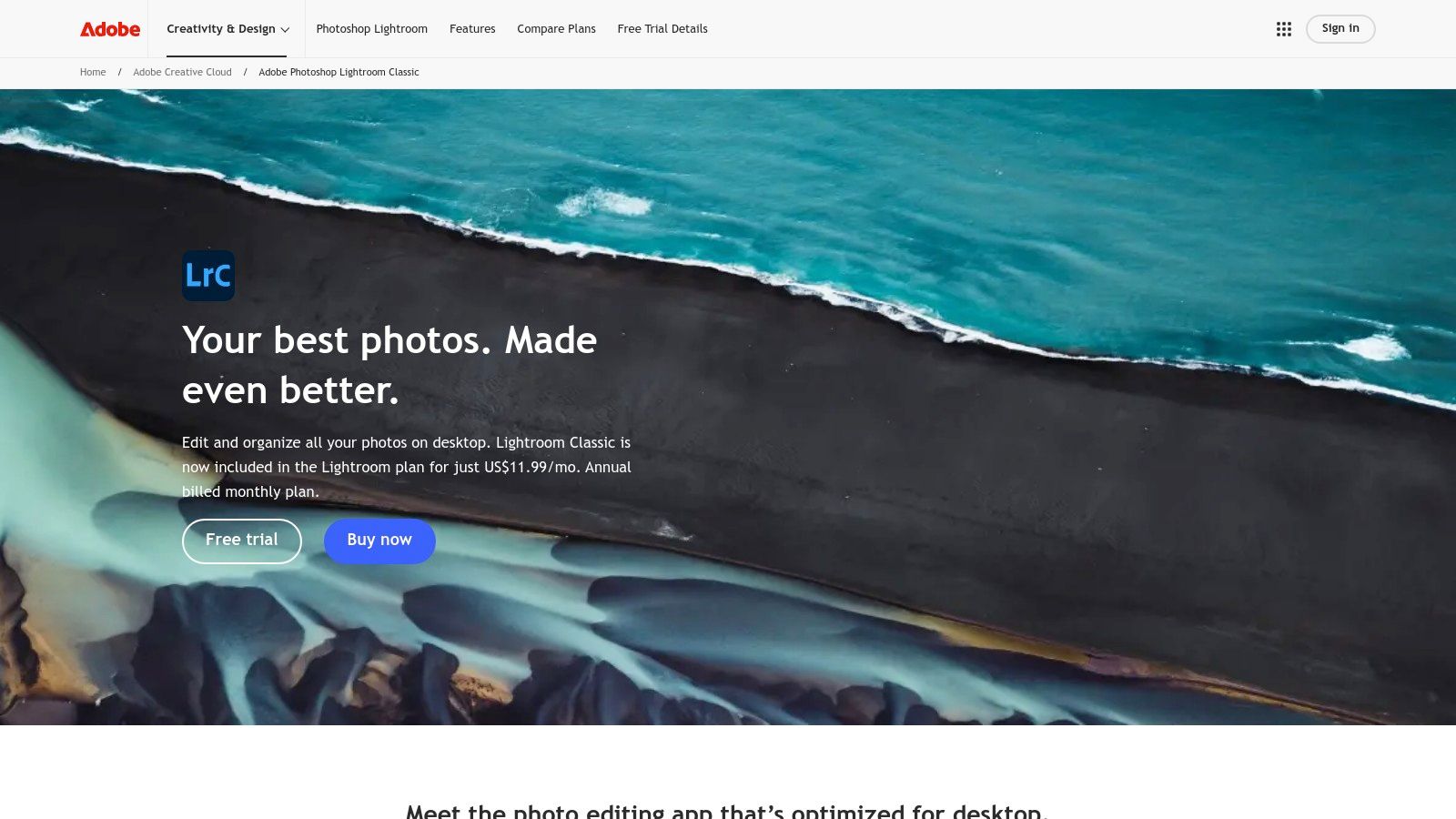
Lightroom Classic's comprehensive toolset is specifically valuable for the demands of real estate photography. You can correct perspective distortions common in architectural photography, balance exposures for interiors with mixed lighting, and enhance colors to make rooms feel inviting. The software's batch processing capabilities ensure a consistent look across an entire property shoot, saving you valuable time and effort. This consistency is crucial for presenting a professional and cohesive image of a property to potential buyers. Realtors, real estate companies, and home staging businesses all benefit from the polished, professional results achievable with Lightroom.
For real estate agents and realtors, efficiently managing visuals is critical. Lightroom Classic's catalog system allows you to organize photos from multiple properties, making it easy to find and edit images for specific listings. Imagine seamlessly transitioning from editing photos of a modern condo to a sprawling ranch house, all within a well-structured catalog. This level of organization streamlines your workflow, enabling faster turnaround times and increased productivity.
Features
- Advanced RAW photo processing capabilities
- Perspective correction and lens distortion removal tools
- Catalog system for organizing multiple property shoots
- Batch processing for consistent editing across property images
- Seamless integration with Photoshop for advanced editing
Pros
- Comprehensive toolset specifically designed for real estate editing
- Non-destructive editing preserves original files
- Efficient workflow with presets and batch processing
- Industry standard with extensive learning resources available
Cons
- Subscription-based pricing ($9.99/month with Adobe's Photography Plan)
- Can be resource-intensive on older computers
- Steeper learning curve for beginners
- Requires regular catalog maintenance for optimal performance
Implementation/Setup Tips
- Create a structured catalog system: Organize your photos by property address or client name to maintain a clear and efficient workflow.
- Develop Presets: Save your preferred editing settings as presets to quickly apply consistent edits across multiple images.
- Utilize Batch Processing: Edit a single image and then apply those edits to a whole set of photos from the same shoot, ensuring a cohesive look.
- Explore Tutorials: Numerous online resources are available to help you master Lightroom Classic's features, from basic adjustments to advanced techniques.
Website: https://www.adobe.com/products/photoshop-lightroom-classic.html
Lightroom Classic is more than just software; it's an investment in your real estate photography business. It's the key to unlocking the full potential of your images, transforming them into powerful marketing tools that attract buyers and close deals. While the subscription cost and learning curve might seem daunting initially, the long-term benefits in terms of efficiency, quality, and professional presentation make it a worthwhile addition to your real estate photography equipment arsenal.
8-Item Real Estate Photography Gear Comparison
| Product | Core Features & Capabilities | User Experience & Quality ★★★★☆ | Value & Pricing 💰 | Target Audience 👥 | Unique Selling Points ✨ |
|---|---|---|---|---|---|
| 🏆 Pedra | AI virtual staging, renders, video tours, floor plans | Intuitive, no technical skill needed, 5★ rating | Flexible subscription €29/mo, 100 images | Real estate agents, agencies | One-click AI, all-in-one platform, pro editing services |
| Canon EOS 5D Mark IV | 30.4MP full-frame DSLR, 4K video, 61-point AF | Exceptional image quality, weather-sealed | ~$2,500 body only | Professional real estate photographers | High dynamic range, reliable autofocus |
| Sony Alpha a7 III | 24.2MP mirrorless, 5-axis IBIS, 693-point AF, 4K HDR video | Compact, excellent low-light, long battery life | ~$1,998 body only | Advanced photographers, pros | Lightweight, superior low-light, mirrorless benefits |
| Canon TS-E 24mm f/3.5L II Lens | Tilt-shift 24mm, perspective control, ultra-sharp optics | Exceptional sharpness, manual focus | ~$1,899 MSRP | Architecture & real estate pros | Corrects perspective distortion, minimal image distortion |
| Manfrotto MT055XPRO3 Tripod | 66.9" max height, 19.8 lbs load, horizontal center column | Stable, durable, versatile | ~$250 | Real estate photographers | Horizontal center column, quick leg locks |
| Godox AD200Pro Flash | 200Ws, interchangeable heads, wireless, TTL/manual modes | Portable, versatile flash power | ~$349 | Real estate photographers | Portable with strong lighting, interchangeable heads |
| DJI Mavic 3 Drone | Hasselblad 20MP, 46 min flight, obstacle sensing | Superior aerial quality, compact | ~$2,049 | Real estate marketers, photographers | Pro aerial shots, long flight, advanced safety features |
| Adobe Lightroom Classic | RAW editing, perspective correction, batch processing | Industry standard, non-destructive edits | $9.99/mo (Photography Plan) | Photographers, editors | Powerful editing, catalog organization |
Ready to Capture Stunning Real Estate Photography?
From cameras like the Canon EOS 5D Mark IV and Sony Alpha a7 III to specialized equipment like the Canon TS-E 24mm tilt-shift lens and the versatile DJI Mavic 3 drone, the right real estate photography equipment can transform your listings. Coupled with essential tools like the Manfrotto tripod and Godox flash, and enhanced by software like Adobe Lightroom Classic, these tools empower you to create truly captivating visuals. Remember, choosing the best real estate photography equipment depends on your specific needs and budget. Consider factors like image quality, portability, and ease of use when making your selections. Just as a thoughtful security screen investment can enhance your property's value and safety, according to XL Security and Blinds' article Are Crimsafe Screens Worth It?, investing in quality photography equipment significantly elevates your marketing materials and attracts potential buyers.
The most important takeaway? High-quality visuals are crucial for success in today's competitive real estate market. By mastering the use of these powerful tools, you'll not only showcase properties in their best light but also establish yourself as a professional committed to excellence.
Want to take your real estate photography to the next level? Explore Pedra, an innovative AI tool designed to streamline your workflow and enhance your images. Pedra helps you perfect your photos quickly and easily, saving you valuable time and effort in post-production.

Related Posts
Top 7 AI Room Decoration Tools for 2025
Discover the best AI room decoration software for 2025. Our review compares top tools to help you de...
9 Curb Appeal Ideas on a Budget That Actually Work (2025)
Transform your home's exterior with our top curb appeal ideas on a budget. Get easy, high-impact tip...
10 Essential Curb Appeal Improvements for 2025
Discover 10 essential curb appeal improvements to boost property value. This guide for real estate p...